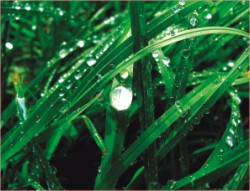Feature
Rhythm of Rains
Mohammad Shafiqul Islam
“Neel nabogone ashar gogone til thai ar nahire,
Ogou aj tura jasne ghorer bahire”.
(There is little space in the new blue sky of ashar,Hey, do not go out of home today.)
We did not go out on the first day of the Rainy Season (Barsha) following the world poet's graceful beseech in the poem 'Ashar'. The nature was in its own appearance on this day. It was a holiday and most of the people of different cities in Bangladesh spent their idle time at home. The sun was not visible the whole day long in most of the places of the country. Sometimes it was raining cats and dogs, sometimes it was drizzling. The poetic atmosphere was in the minds.
 We read two poems 'Ashar' and 'Nabobarsho' on the first day of Barsha 1414. It was really a pleasing experience to stay home and read Tagore's Barsha poems and enjoy the music of rains on the day. Enjoying Tagore's song ' Borisho dhorar majhe shantiro bari, shushko hridoyo loye achche daraye urdho mukhe noro-nari', and Nazrul's song 'Meghero dumuro ghono baje, bijli chomkay, amaro mono chay, moner moyur jeno shaje' on such a day added sweet feelings to life. We read two poems 'Ashar' and 'Nabobarsho' on the first day of Barsha 1414. It was really a pleasing experience to stay home and read Tagore's Barsha poems and enjoy the music of rains on the day. Enjoying Tagore's song ' Borisho dhorar majhe shantiro bari, shushko hridoyo loye achche daraye urdho mukhe noro-nari', and Nazrul's song 'Meghero dumuro ghono baje, bijli chomkay, amaro mono chay, moner moyur jeno shaje' on such a day added sweet feelings to life.
Nature is beautiful, celestial, and spotless. It appears in diverse forms with the passage of time. One season goes, another season comes and the nature gets splendidly decorated. Nature in Bangladesh speaks with the herald of a new season. The Cuckoo as the harbinger of Spring sings tunefully. All other seasons have the usual signs which entail people to get readied to welcome them.
Bangladesh is called the land of six seasons. It has a temperate climate because of its physical location. The climate of Bangladesh is mainly sub-tropical monsoon, warm and humid. Out of six seasons Barsha is a fine one. Each season comprises two months, but some seasons flow into other seasons while others are short.
Barsha appeared in a different form this year indeed! It came with the omen of deluge to create more unbearable sufferings for the people in Bangladesh. Nature's cruel behavior in some parts of the country was followed by Barsha 1414. Chittagong, the port city, faced with the most tragic landslides in the history. About two hundred people lost their valuable lives and hundreds of people turned homeless and helpless. The beautiful city suddenly got reshaped as the debris of deaths and destructions. Most other cities have also been inundated and the people in those cities are still in great troubles. Even Dhaka, the capital city of Bangladesh, is dangerously waterlogged. People there are unable to lead their usual life.
The rainy season (Barsha) traditionally spreads over Ashar and Shrabon (mid-June to mid-August). However, the rainy season may start from the end of Baishakh and last up to the beginning of Kartik (mid-May to late-October). During the rainy season, the southwest monsoon winds bring plenty of rainfall and occasionally lasting for days without end without any respite. Most of the floodplains of the country remain inundated during this period. Depending upon the local elevation, the depth and duration of Barsha varies in different parts of Bangladesh. For instance, in low lying parts inundation lasts for the longest period. In the rural areas, boat navigation becomes a common mode of transport during this season.
Barsha is also important for the fishing community of Bangladesh. Hilsha fish is available in plenty during this season. The inundated floodplains become a large habitat for a wide variety of aquatic flora and fauna. At this time plenty of edible herbs grow everywhere, as does the national flower lotus. This is the season for keya, kadam, kamini, jui, gandhoraj and other fragrant flowers, as well as fruits like guava, pineapple, blackberry, lychee.
Though it is Barsha, it does not lag behind in comparison to other seasons regarding scenes and sounds. I do love my country, I do love all seasons; but Barsha wins my heart for the rhythmic sounds of its rains. The rain drops make the sparkle like diamonds which result in shantir bari (tranquil water). My heart on this day was dancing with the rhythm of 'Hridoy amar nachere ajike, moyurer moto nachere, hridoy nachere, nachere' (Heart mine dances, oh it dances, like the peacock).
Lecturer, Department of English
Metropolitan University, Sylhet
E-mail: msijewel@gmail.com
| 